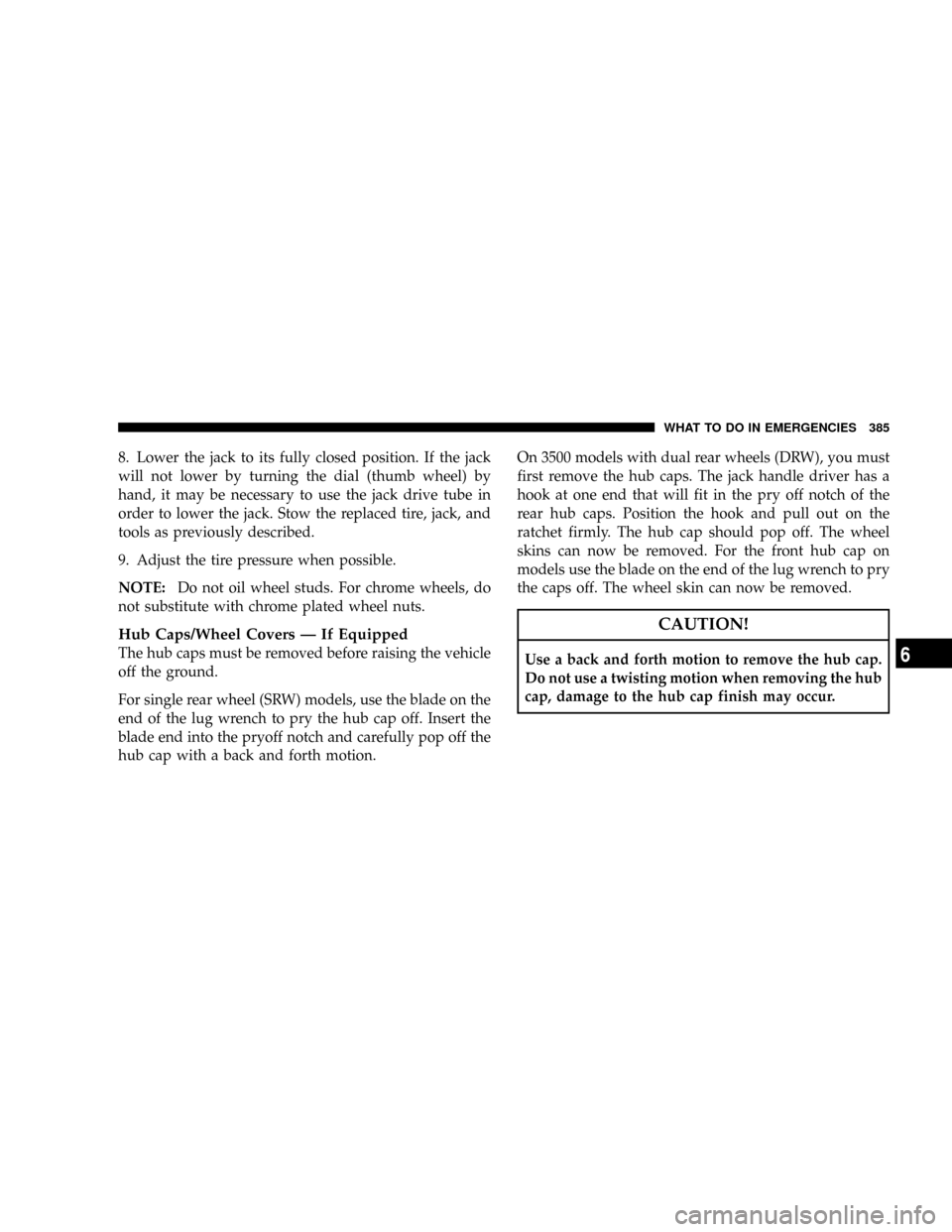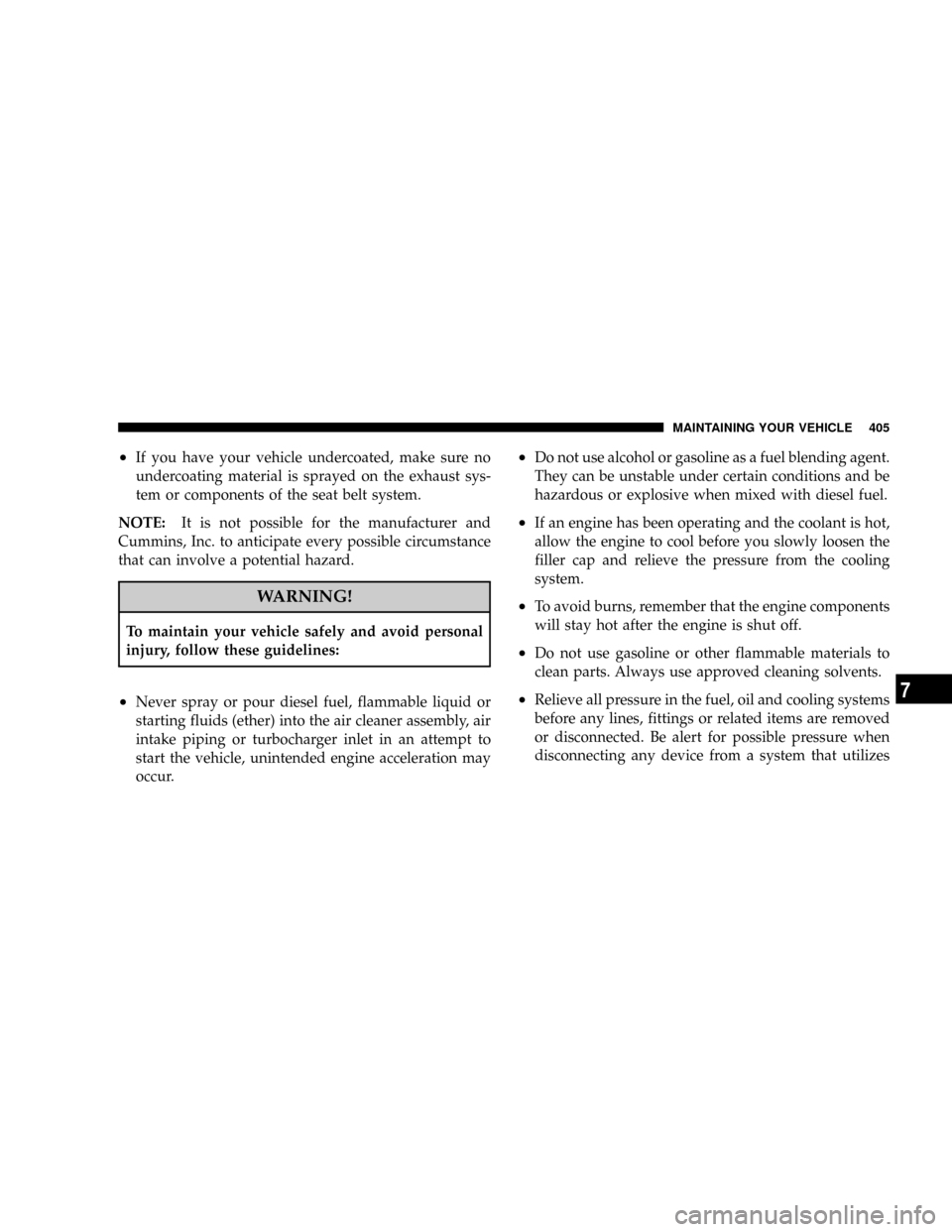Page 337 of 528

ENGINE RUNAWAY
WARNING!
In case of engine runaway due to flammable fumes
from gasoline spills or turbocharger oil leaks being
sucked into the engine do the following to help avoid
personal injury and/or vehicle damage:
1. Shut off engine ignition switch.
2. Using a CO
2or dry chemical type fire extin-
guisher, direct the spray from the fire extinguisher
into the grille on the passenger side so that the spray
enters the engine air intake.
The inlet for the engine air intake is located behind
the passenger side headlamp and receives air
through the grille
FUEL REQUIREMENTS
Fuel Requirements (5.7L Gas Engines)
The 5.7L engine is designed to meet all
emissions regulations and provide satisfac-
tory fuel economy and performance when
using high quality unleaded gasoline hav-
ing an octane range of 87 to 89. The manu-
facturer recommends the use of 89 octane
for optimum performance. The routine use of premium
gasoline is not recommended. The use of premium
gasoline will provide no benefit over high quality regular
and mid-grade gasolines, and in some circumstances
may result in poorer performance.
Light spark knock at low engine speeds is not harmful to
your engine. However, continued heavy spark knock at
high speeds can cause damage and immediate service is
required.
STARTING AND OPERATING 337
5
Page 385 of 528

8. Lower the jack to its fully closed position. If the jack
will not lower by turning the dial (thumb wheel) by
hand, it may be necessary to use the jack drive tube in
order to lower the jack. Stow the replaced tire, jack, and
tools as previously described.
9. Adjust the tire pressure when possible.
NOTE:Do not oil wheel studs. For chrome wheels, do
not substitute with chrome plated wheel nuts.
Hub Caps/Wheel Covers Ð If Equipped
The hub caps must be removed before raising the vehicle
off the ground.
For single rear wheel (SRW) models, use the blade on the
end of the lug wrench to pry the hub cap off. Insert the
blade end into the pryoff notch and carefully pop off the
hub cap with a back and forth motion.On 3500 models with dual rear wheels (DRW), you must
first remove the hub caps. The jack handle driver has a
hook at one end that will fit in the pry off notch of the
rear hub caps. Position the hook and pull out on the
ratchet firmly. The hub cap should pop off. The wheel
skins can now be removed. For the front hub cap on
models use the blade on the end of the lug wrench to pry
the caps off. The wheel skin can now be removed.
CAUTION!
Use a back and forth motion to remove the hub cap.
Do not use a twisting motion when removing the hub
cap, damage to the hub cap finish may occur.
WHAT TO DO IN EMERGENCIES 385
6
Page 386 of 528
CAUTION!
The rear hub caps on the dual rear wheel has two pry
off notches. Make sure that the hook of the jack
handle driver is located squarely in the cap notch
before attempting to pull off.
You must use the flat end of the lug wrench to pry off the
wheel skins. Insert the flat tip completely and using a
back and forth motion, loosen the wheel skin. Repeat this
procedure around the tire until the skin pops off.
Replace the wheel skins first using a rubber mallet. When
replacing the hub caps, tilt the cap retainer over the
lugnut bolt circle and strike the high side down with a
rubber mallet. Be sure that the hub caps and wheel skins
are firmly seated around the wheel.
Dual Rear Wheels
Dual wheels are flat mounted, center piloted. The lug
nuts are a two piece assembly. When the tires are being
rotated or replaced, clean these lug nuts and add 2 drops
of oil at the interface between the hex and the washer.
386 WHAT TO DO IN EMERGENCIES
Page 397 of 528
MAINTAINING YOUR VEHICLE
CONTENTS
mEngine Compartment Ð 6.7L Diesel Engine....400
mEngine CompartmentÐ 5.7L Gas Engine......401
mOnboard Diagnostic System (OBD II).........402
NLoose Fuel Filler Cap Message............402
mReplacement Parts......................403
mEngine Data Plate......................403
mDealer Service.........................403
mService Information.....................404
mMaintenance Procedures..................406NEngine Oil..........................406
NDrive Belts (Gas Engines)...............413
NDrive Belt (Diesel Engines)..............413
NEngine Air Cleaner Filter (Gas Engines).....413
NEngine Air Cleaner Filter (Diesel Engines)....414
NDraining Fuel/Water Separator Filter (Diesel
Engines)............................417
NEngine Fuel Filter (Gas Engines)...........420
NSpark Plugs (Gas Engines)...............420
7
Page 405 of 528

²If you have your vehicle undercoated, make sure no
undercoating material is sprayed on the exhaust sys-
tem or components of the seat belt system.
NOTE:It is not possible for the manufacturer and
Cummins, Inc. to anticipate every possible circumstance
that can involve a potential hazard.
WARNING!
To maintain your vehicle safely and avoid personal
injury, follow these guidelines:
²Never spray or pour diesel fuel, flammable liquid or
starting fluids (ether) into the air cleaner assembly, air
intake piping or turbocharger inlet in an attempt to
start the vehicle, unintended engine acceleration may
occur.
²Do not use alcohol or gasoline as a fuel blending agent.
They can be unstable under certain conditions and be
hazardous or explosive when mixed with diesel fuel.
²If an engine has been operating and the coolant is hot,
allow the engine to cool before you slowly loosen the
filler cap and relieve the pressure from the cooling
system.
²To avoid burns, remember that the engine components
will stay hot after the engine is shut off.
²Do not use gasoline or other flammable materials to
clean parts. Always use approved cleaning solvents.
²Relieve all pressure in the fuel, oil and cooling systems
before any lines, fittings or related items are removed
or disconnected. Be alert for possible pressure when
disconnecting any device from a system that utilizes
MAINTAINING YOUR VEHICLE 405
7
Page 406 of 528

pressure. Do not check for pressure leaks with your
hand. High pressure oil or fuel can cause personal
injury.
WARNING!
Do not open the high pressure fuel system with the
engine running. Engine operation causes high fuel
pressure. High pressure fuel spray can cause serious
injury or death.
²Important:All maintenance other than that listed in
this manual, as well as some procedures listed here,
MUSTbe performed by your local Dodge Truck
Dealer. Your authorized Dodge Dealer has been
trained and has the necessary parts to maintain your
engine.
MAINTENANCE PROCEDURES
The pages that follow contain therequiredmaintenance
services determined by the engineers who designed your
vehicle.
Besides the maintenance items for which there are fixed
maintenance intervals, there are other items that should
operate satisfactorily without periodic maintenance.
However, if a malfunction of these items does occur, it
could adversely affect the engine or vehicle performance.
These items should be inspected if a malfunction is
observed or suspected.
Engine Oil
Checking Oil Level
To assure proper lubrication of your vehicle's engine, the
engine oil must be maintained at the correct level. Check
the oil level at regular intervals. The best time to check
the oil level is before starting the engine after it has been
parked overnight. When checking oil after operating the
406 MAINTAINING YOUR VEHICLE
Page 407 of 528
engine, first ensure the engine is at full operating tem-
perature, then wait for 30 minutes (6.7L Diesel Engine),
and 15 minutes (5.7L Gas Engine) after engine shutdown
to check the oil.
Checking the oil while the vehicle is on level ground will
improve the accuracy of the oil level readings. Always
maintain the oil level within the SAFE zone on the
dipstick. Adding one quart of oil when the reading is at
the bottom of the SAFE zone will result in a reading at the
top of the safe zone on these engines.
CAUTION!
Overfilling or underfilling the crankcase will cause
oil aeration or loss of oil pressure. This could damage
your engine.Never operate the engine with oil level below the ªADDº
mark or above the upper ªSAFEº mark.
Change Engine Oil (Gas Engines)
Follow the Gas Engine Maintenance Schedule for recom-
mended engine oil change intervals.
MAINTAINING YOUR VEHICLE 407
7
Page 408 of 528

Engine Oil Selection (Gas Engines)
For best performance and maximum protection under all
types of operating conditions, the manufacture only
recommends engine oils that are API certified and meet
the requirements of DaimlerChrysler Material Standard
MS-6395. Use Mopar or an equivalent oil meeting the
specification MS-6395.
American Petroleum Institute (API) Engine Oil
Identification Symbol
This symbol means that the oil has
been certified by the American
Petroleum Institute (API). The
manufacture only recommends
API Certified engine oils.
Engine Oil Viscosity (SAE Grade)
For trucks with a 5.7L engine operating under a gross
combined weight rating of 14,000 lbs or greater, SAE
5W-30 engine oil is recommended for all operating
temperatures. For all other trucks with a 5.7L engine,
operating under a gross weight rating less than 14,000
lbs SAE 5W-20 engine oil is recommended for all
operating temperatures. These engine oils improve low
temperature starting and vehicle fuel economy. Your
engine oil filler cap also shows the recommended
engine oil viscosity for your vehicle.
For information on engine oil filler cap location, see the
Engine Compartment illustration in this section.
Lubricants which do not have both, the engine oil certi-
fication mark and the correct SAE viscosity grade num-
ber should not be used.
408 MAINTAINING YOUR VEHICLE